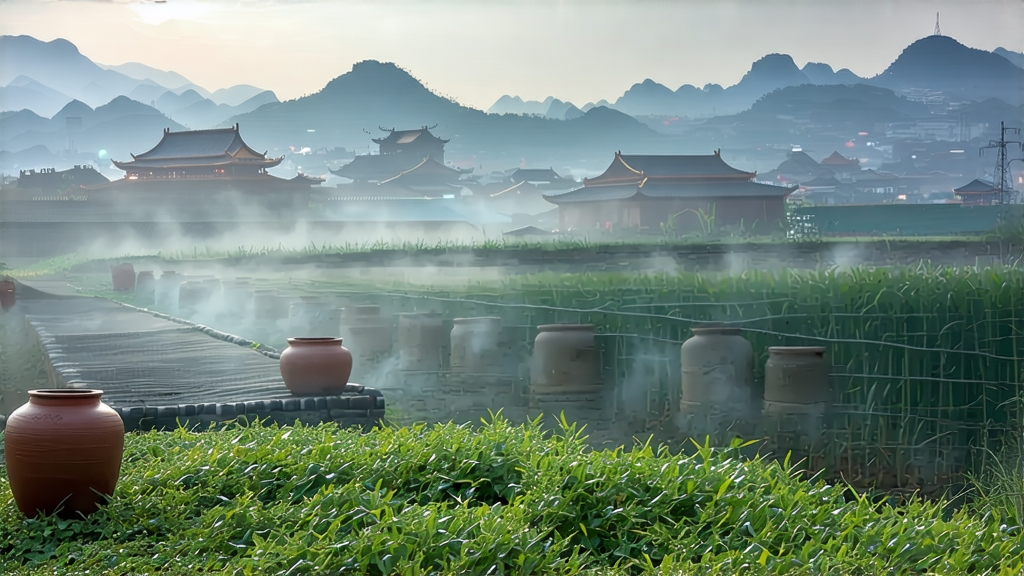
Tucked away in the humid, karst-pocked hills of southern Guangxi, Liupao tea has spent four centuries quietly transforming from a rough frontier commodity into one of China’s most intriguing dark teas. To international drinkers accustomed to the sweet malt of Assam or the bright snap of sencha, Liupao offers a different compass point on the globe of flavor: damp forest floor, pipe tobacco, longan, and a cooling betel-nut finish that lingers like distant incense. Understanding Liupao means stepping into a micro-climate where microbes outnumber people, where tea leaves are reborn through controlled decay, and where time itself is an ingredient measured not in minutes but in decades.
Historical footprints
The name first appears in the Qing-era “Chronicles of Cangwu County” (1857), noting that “merchant junks sail down the Xun River with baskets of Liu-pu tea bound for Guangzhou and Hong Kong.” The spelling “pu” later mutated into “pao,” meaning “fermentation heap,” a nod to the tea’s defining process. British customs logs from 1886 list Liupao as “Black Basket Tea,” taxed lower than Keemun but higher than Wuyi rock teas, proof that London brokers already recognized its unique market niche. During the Pacific War the tea road was severed; Liupao retreated into domestic obscurity until the 2006 rise of dark-tea speculation sent collectors rummaging through musty granaries for 1950s vintages priced like first-growth Bordeaux.
Terroir and leaf
Guangxi’s subtropical monsoon delivers 1,600 mm of rain annually, wrapping the tea mountains in a perpetual cloud blanket that rarely drops below 75 % humidity. The indigenous large-leaf variety, Camellia sinensis var. sinensis f. pubilimba, develops leaves the size of a child’s palm, thick enough to withstand the aggressive wet-piling that would turn lesser cultivars into compost. Farmers pick one bud plus the fourth or even fifth leaf—material too coarse for green tea but perfect for Liupao, because broader blades carry more polysaccharides that later feed the microbial consortia.
Crafting the darkness
The journey begins like any green tea: pluck, wither, kill-green in a 280 °C drum for three minutes to arrest oxidation. Then Liupao diverges. While still warm, the leaves are rolled for 45 minutes to rupture cells and release mucilage. The crucial act is “wet-piling” (wo dui): leaves are sprayed with mountain spring water, stacked 70 cm high under bamboo mats, and left to ferment for 10–12 hours. Internal temperatures climb to 55 °C, activating thermophilic bacteria akin to those in Alpine cheese caves. Every hour a master called the “nose” thrusts his bare arm into the heap, sniffing for the switch from grassy to dried-longan sweetness; when that moment arrives the pile is broken down and sun-dried on bamboo trays. Finally the tea is steamed, packed into 40 kg cylindrical bamboo baskets, and hung above kitchen hearths for slow charcoal drying that can last 30 days. Smoke compounds mingle with microbial metabolites, gifting the signature “pine-litchi” aroma that distinguishes Liupao from Hunan’s Fu brick or Yunnan’s shou puerh.
Aging alchemy
Unlike puerh, which needs breathable wrappers, Liupao prefers airtight terracotta jars. The absence of oxygen shifts the microbial cast from aerobic yeasts to anaerobic Clostridium species that cleave tannins into softer pyrogallols, turning the liquor from amber to mahogany and the taste from rough to syrupy. A 1999 study at the Chinese Academy of Agricultural Sciences tracked catechin degradation: after 15 years (-)-EGCG drops 62 %, while theaflavin polymers rise 340 %, explaining the deepening color and the emergence of camphor and jujube notes. Connoisseurs speak of “three stages”: young (1–5 yrs) brisk and smoky; mature (6–15 yrs) mellow with dried fruit; vintage (16 yrs +) silky, mineral, almost Burgundian in complexity.
Grades and shapes
The traditional basket (“long篓”) remains the icon, but modern producers offer compressed bricks (250 g), mini tuos (5 g), and even chocolate-bar break-offs for convenience. Grading follows leaf size: Special Grade (≥ 50 % tips), First Grade (30 % tips), down to Fifth Grade